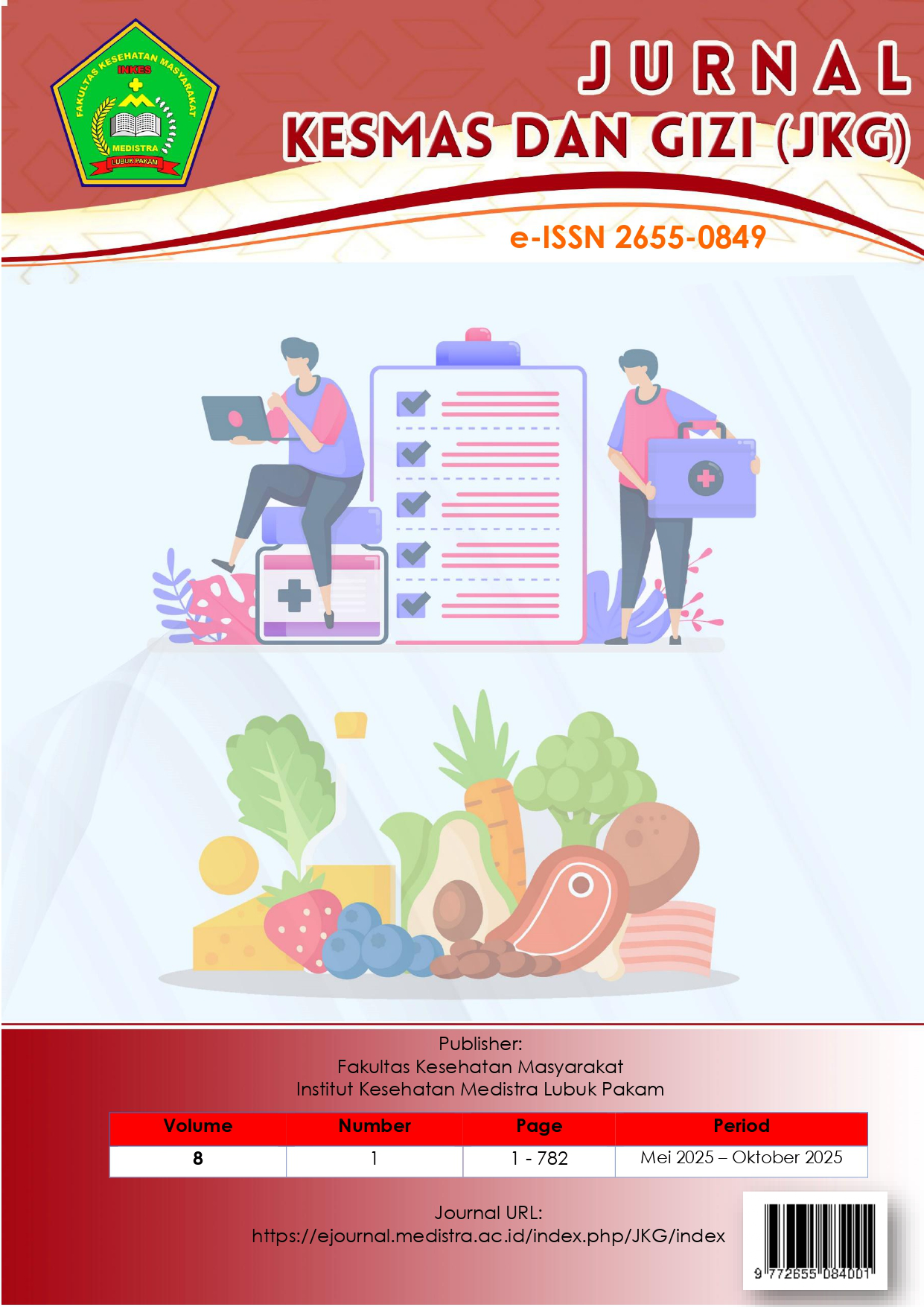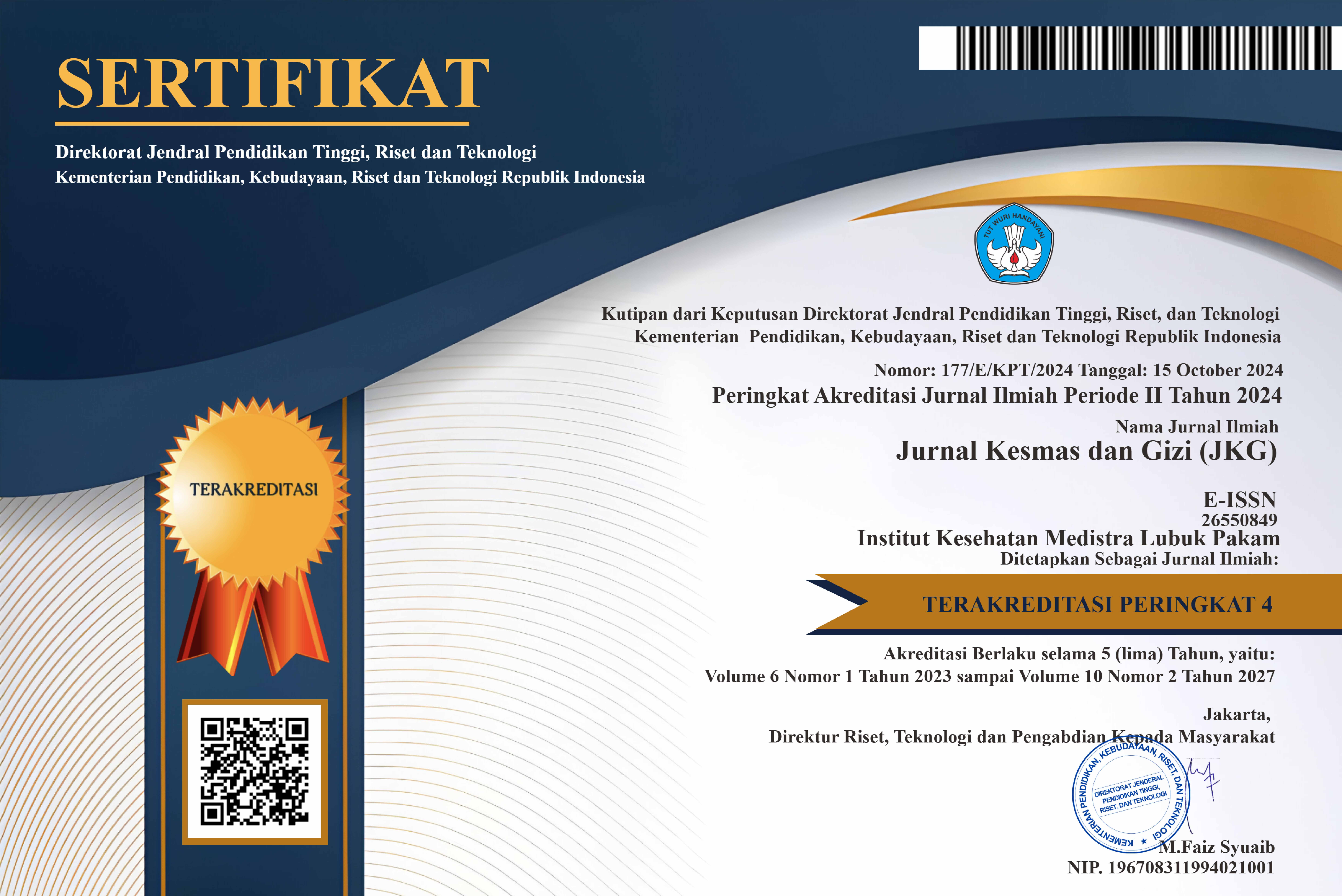The Relationship Between Ultra-Processed Food Consumption Patterns and Nutritional Status Among Indonesian Adolescents: A Systematic Review
DOI:
https://doi.org/10.35451/yxdhpt73Keywords:
ultra-processed foods, nutritional status, adolescents, obesity, dietary pattern.Abstract
Background: Nutritional problems among children and adolescents remain a major public health issue in Indonesia, with challenges including both undernutrition and overnutrition. One contributing factor is the increasing consumption of ultra-processed foods (UPF), especially among adolescents. UPFs are industrially processed foods that are high in energy, fat, sugar, and salt, but low in essential nutrients. Objective: To evaluate the relationship between UPF consumption and nutritional status among adolescents. Methodology: This study used an observational design based on data from a systematic review. Results and Discussion: A review of various national and international studies shows that most research found a positive association between high UPF consumption and excessive nutritional status, such as overweight and obesity. However, some studies did not show a significant relationship, which may be influenced by other factors such as physical activity, sedentary behavior, and socioeconomic conditions. Furthermore, the type of UPF consumed also affects its impact on nutritional status, with energy-dense foods showing a stronger correlation than beverages. Conclusion: High consumption of ultra-processed foods has the potential to be an independent risk factor for excessive nutritional status in adolescents, although individual characteristics and lifestyle variability should be considered as moderating factors in this relationship.
Downloads
References
[1] D. Herliani, “Hubungan Kebiasaan Jajan Dan Pola Makan Dengan Status Gizi Anak Di Tk Asri Palembang Tahun 2022,” J. Ilm. Multi Disiplin Indones., vol. 1, no. 6, pp. 801–809, 2022.
[2] N. N. Utami, “Analisis gaya hidup pada perilaku konsumsi remaja,” J. Adm. dan Bisnis, vol. 15, no. 2, 2021.
[3] F. Nikmah, “Kebiasaan Konsumsi Fast Food dan Junk Food pada Remaja,” J. Ilm. Gizi dan Kesehat., vol. 5, no. 02, pp. 57–61, 2024.
[4] I. Pamelia, “Perilaku Konsumsi Makanan Cepat Saji Pada Remaja Dan Dampaknya Bagi Kesehatan,” J. IKESMA, vol. 14, no. 5, pp. 144–153, 2018.
[5] D. Widyatnoko, M. Budiharsana, and A. Prabawa, “Pengembangan Aplikasi Konsultasi Dan Pengukuran Status Gizi Usia Remaja ( SMA ) Secara Online ( Nutri-O ),” J. Kesmas Gizi, vol. 2, no. 2, pp. 109–113, 2020.
[6] C. A. Monteiro et al., “Commentary Ultra-processed foods : what they are and how to identify them,” Public Health Nutr., vol. 22, no. 5, pp. 936–941, 2019, doi: 10.1017/S1368980018003762.
[7] Food and Agriculture Organization of the United Nations, The State of Food Security and Nutrition in The World. Rome, 2018.
[8] J. C. Lumanlan, W. Mary, A. Dipika, and B. Fernando, “Mechanisms of oil uptake during deep frying and applications of predrying and hydrocolloids in reducing fat content of chips,” Int. J. Food Sci. Technol., vol. 55, pp. 1661–1670, 2020, doi: 10.1111/ijfs.14435.
[9] S. Asokapandian, G. J. Swamy, and H. Hajjul, “Deep fat frying of foods : A critical review on process and product parameters,” Crit. Rev. Food Sci. Nutr., vol. 0, no. 0, pp. 1–14, 2019, doi: 10.1080/10408398.2019.1688761.
[10] A. I. Olagunju, O. S. Omoba, and O. O. Awolu, “Physiochemical , Antioxidant Properties and Carotenoid Retention / Loss of Culinary Processed Orange Fleshed Sweet Potato,” 2020.
[11] D. Ramdhana, “Hubungan pola konsumsi junk food dan ultra processed food dengan kadar hemoglobin pada remaja putri di sman 22 makassar,” Universitas Hasanuddin, 2023.
[12] P. D. Maulidina, Muh. Khidri Alwi, Sitti Patimah, Muhammad Ikhtiar, and Yusriani, “Pengaruh Konsumsi Makanan Atau Minuman Ultra Processed Terhadap Kejadian Kegemukan Pada Remaja Putri Di SMK-SMAK Makassar,” Wind. Public Heal. J., vol. 6, no. 2, pp. 274–282, 2025, doi: 10.33096/woph.v6i2.779.
[13] I. Yanaina et al., “Ultra ‑ processed food consumption in UK adolescents : distribution , trends , and sociodemographic correlates using the National Diet and Nutrition Survey 2008 / 09 to 2018 / 19,” Eur. J. Nutr., vol. 63, no. 7, pp. 2709–2723, 2024, doi: 10.1007/s00394-024-03458-z.
[14] J. Wang, R. Luben, K. T. Khaw, S. Bingham, N. J. Wareham, and N. G. Forouhi, “Dietary Energy Density Predicts the Risk of Incident Type 2 Diabetes The European Prospective Investigation of Cancer ( EPIC ) -Norfolk Study,” Epidemiol. Serv. Res., vol. 31, no. 11, pp. 2120–2125, 2008, doi: 10.2337/dc08-1085.
[15] H. Y. Putra and A. H. Santoso, “Perbandingan Indeks Massa Tubuh pada Siswa dan Siswi Konsumsi Ultra-Processed Food di SMA Xaverius 1 Jambi,” Malahayati Nurs. J., vol. 6, no. 12, pp. 5111–5122, 2024, doi: 10.33024/mnj.v6i12.15823.
[16] S. M. D. Ginting, J. Februhartanty, and H. Khusun, “Association between consumption of ultra-processed foods and beverages with nutritional status of private senior high school students in Pontianak, West Kalimantan, Indonesia,” World Nutr. J. |eISSN, vol. 7, no. 2, pp. 90–103, 2024, doi: 10.25220/WNJ.V07.i2.0011.
[17] U. Food, “The influence of ultra-processed food consumption in anthropometric and atherogenic indices of adolescents,” ULTRA-PROCESSED FOOD Atherog., pp. 1–13, 2021.
[18] S. Fedde, A. S. S. Plachta-danielzik, M. James, and M. Anja, “Ultra-processed food consumption and overweight in children , adolescents and young adults : Long-term data from the Kiel Obesity Prevention Study ( KOPS ) Study population,” no. January 2024, pp. 1–11, 2025, doi: 10.1111/ijpo.13192.
[19] F. Lauria et al., “Ultra-processed foods consumption and diet quality of European children, adolescents and adults: Results from the I.Family study,” Nutr. Metab. Cardiovasc. Dis., 2021, doi: 10.1016/j.numecd.2021.07.019.
[20] H. R. Putri, A. Setyaningsih, and N. C. Nurzihan, “Hubungan Aktivitas Sedentari Dan Konsumsi Ultra-Processed Foods Dengan Status Gizi Mahasiswa Universitas Kusuma Husada Surakarta,” J. Gizi dan Pangan Soedirman, vol. 7, no. 1, pp. 49–61, 2023.
[21] M. Irmanto, A. Irjayanti, and A. A. Maranden, “Studi Kegemukan Anak Usia Taman Kanak-Kanak Di Kota J Tahun 2020,” J. Kesehat. Masy. Gizi, vol. 6, no. 2, pp. 289–296, 2024.
Downloads
Published
Issue
Section
License
Copyright (c) 2025 Yessy Fitriani, Apri Yulda, A, Farhan Firmansyah

This work is licensed under a Creative Commons Attribution 4.0 International License.
Copyright in each article is the property of the Author.


























